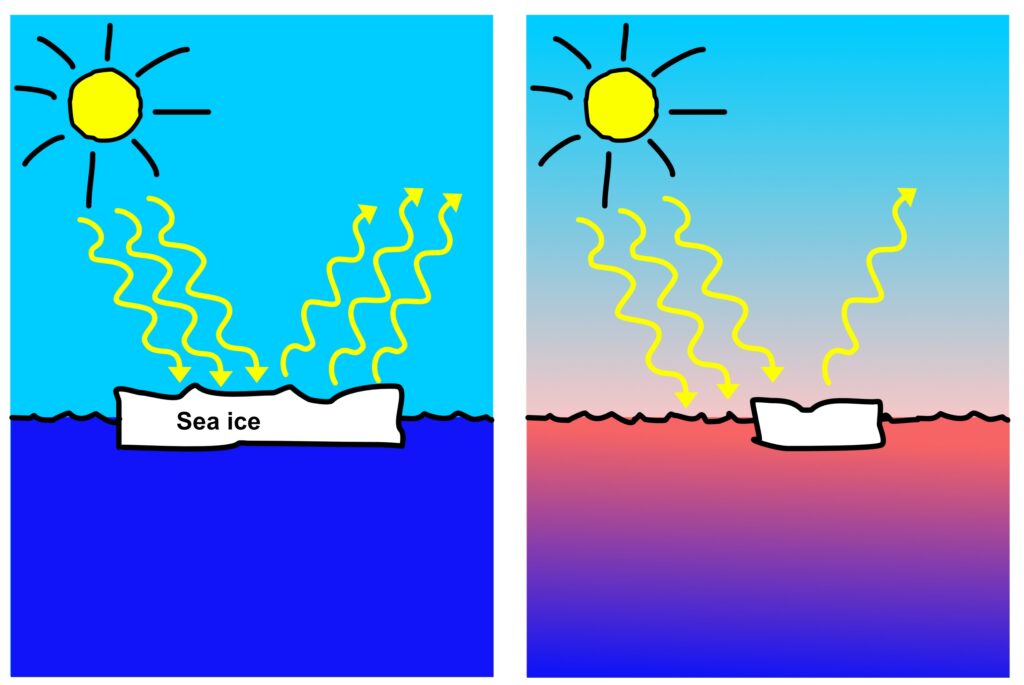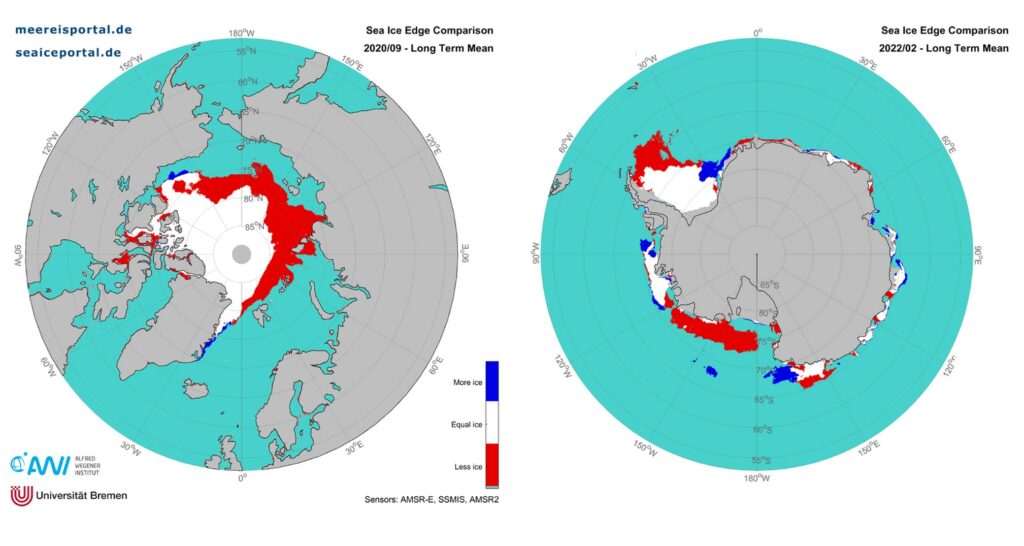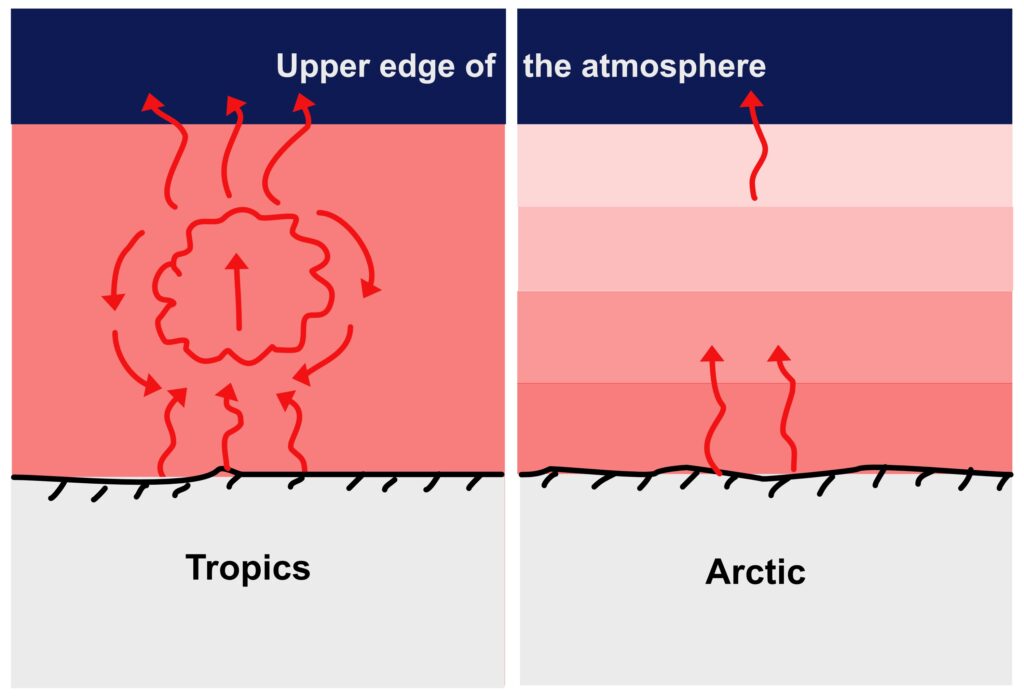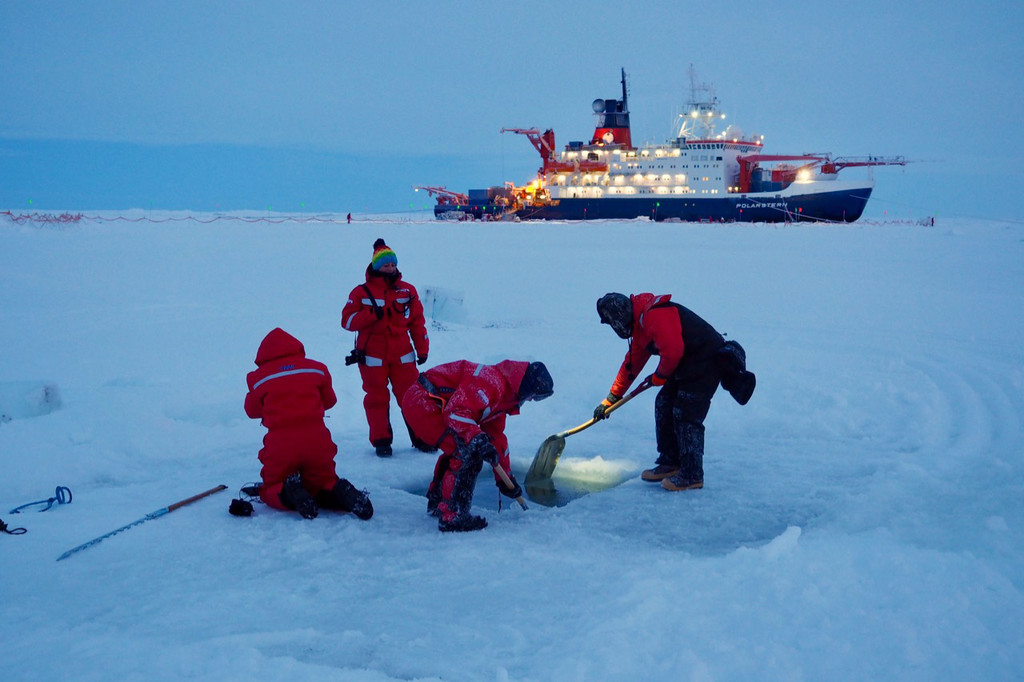What is Polar Amplification and why is it important?
Global warming affects different parts of the world differently. The image above illustrates the temperature changes over the last sixty years using warming stripes for the Arctic, Northern Midlatitudes, Tropics, Southern Midlatitudes, and Antarctic. All zones were getting warmer since the 1990s, but the Arctic is warming particularly strongly. In fact, the Arctic has warmed two to three times more than the rest of the world in recent decades. This drastic climate change is called Arctic amplification, and it has serious implications for local ecosystems and the people who live there, as well as global consequences:
- Sea level rise due to the melting of the Greenland ice sheet and Arctic sea ice.
- Increase in maritime shipping due to receding sea ice stresses ecosystems and increases risks of environmental damage (for example from oil spills).
- Thawing of permafrost can release increased greenhouse gases and destabilize the subsurface. This can cause billions in damage to buildings, roads, oil and gas pipelines, and industrial facilities.
In Antarctica, increased warming has so far only been observed for the Antarctic Peninsula. Overall, similar amplification mechanisms probably operate in Antarctica as in the Arctic, but the Southern Ocean absorbs much of the heat. As a result, there will be a time lag in the increased warming of air temperatures. However, the rise in ocean temperature may cause the water beneath the ice shelves to warm strongly and melt ice there, contributing to a significant rise in sea level.
It is now assumed that climate change in the polar regions influences the weather and climate in Germany, Europe and other parts of the world via atmospheric and oceanic teleconnections, especially extreme events such as particularly warm or cold winters or heat and dry periods in summer. Polar amplification is a focus of climate research because of its global impact.
Why does polar amplification exist?
Currently, several processes are known to drive Arctic amplification:
Ground albedo effect
The decrease in Arctic sea ice is one of the most important causes of Arctic amplification. The ice surface reflects most of the incoming solar radiation directly back into space. This reflectivity is called albedo. As a result, the polar regions naturally keep our planet cool. Sea ice melt due to global warming exposes the dark ocean surface which absorbs solar radiation. This warms the ocean, and more sea ice melts. The more the ocean can warm up in summer, the thinner newly formed sea ice will become in winter, and the faster the new sea ice can melt in turn.
On land, snow cover plays a similar role. Warming causes the snow cover to melt earlier, and the dark ground surface absorbs more solar radiation and warms. The warmer surface warms the air above it.


Vertical temperature gradient feedback
The atmosphere in the Arctic consists of stable layers of air. The cold, dense air at ground level hardly mixes with the lighter air at altitude. As a result, the warming is particularly strong near the ground, while it is less with increasing altitude. As a result, little heat is released into space at the top of the atmosphere.
In the tropics, on the other hand, warm, moist air can rise unhindered into the air, like above a pot without a lid in which water is being heated. The pot loses heat as it evaporates upward, and the water heats up less rapidly. The stable atmosphere of the Arctic acts like a pot with a lid, trapping heat and thus heating it much faster.

Water vapor and aerosol – cloud interactions
On the one hand, clouds can reflect solar radiation and thus have a cooling effect; this plays a role in the Arctic during the short summers. On the other hand, clouds prevent the heat radiated from the ground from escaping into space and thus have a greenhouse effect. This warming effect of clouds predominates in the Arctic on an annual average, while clouds have a cooling effect in the lower latitudes. In addition, the warming of the Arctic causes more water vapor in the atmosphere through evaporation. Water vapor has a strong greenhouse effect and also contributes to more cloud formation. This further increases the warming.
Increasing aerosol particles (liquid or solid suspended particles in the air) such as soot due to increasing economic use of the Arctic also increases warming in the Arctic. Soot particles in the air and on the snow and ice cover reduce albedo. The retreat of sea ice may also increase the formation of marine aerosols, which are released into the air by bursting air bubbles at the sea surface. In addition, aerosols interact with cloud and chemical processes in the atmosphere, the effects of which are still unknown.
Planck effect
The Planck effect is stabilizing our climate system. As the Earth warms, it also radiates more heat into cold space, cooling itself as a result. Because the polar regions are so much colder than the other zones of the Earth, the release of additional heat is less effective than for example in the warm tropics. Therefore, more heat remains in the polar regions, which further favors polar amplification.
What is research working on?
Due to the global importance of the polar regions, it is crucial to understand the effects of climate change in these regions, also to be able to make realistic predictions for the future. German research on polar amplification focuses on the following questions:
Which processes are essential for polar amplification?
The relative strength of the known forcing mechanisms of polar amplification, their mutual interactions, and their possible changes in a future warmer world are currently unknown.
Is Arctic amplification driven by changes in the lower latitudes?
It is increasingly likely that Arctic amplification is also driven by changes in the lower latitudes. Intrusions of warm and moist air masses from the midlatitudes into the central Arctic play an important role. In addition, more heat is transported to the Arctic by ocean currents. Long-term observations have shown that currents flowing into the Arctic Ocean from the Atlantic have warmed significantly in recent decades.
When and how much polar amplification will occur in Antarctica?
The strong uptake of “anthropogenic heat” by the Southern Ocean plays a crucial role here. In recent decades, the deeper water masses of the Southern Ocean have warmed significantly, more than five times the global warming trend in the deep ocean. In addition, another indication of changes occurring in Antarctica is a decrease and southward shift of westerly wind systems over the Antarctic Circumpolar Current.
How well can weather forecasting and climate models represent changes in the polar regions? What developments are possible for polar amplification in the 21st century and beyond?
For both polar regions, weather and climate forecasts still deviate strongly from observations in some cases. Modelers are currently working on realistic representations of important factors such as ground albedo, ocean eddies, and formation of aerosols, clouds, and precipitation. Interaction processes between the ocean, sea ice, land ice, and atmosphere are very complex. Therefore, it is important to systematically evaluate results from models with continuous measurements from ground stations, radiosondes, satellites, and other observing system components.
What are the impacts of polar amplification on climate and on extreme events in the polar regions and in the midlatitudes – today and in the future?
It is hypothesized that there are linkages between Arctic amplification and midlatitude wind systems and associated extreme events. Examples include warm air intrusions from the midlatitudes into the Arctic, and cold air outbreaks from the Arctic into the midlatitudes. This needs to be verified using observational data and model experiments.
It is now clear that Arctic amplification is contributing to a weakening of ocean currents in the Atlantic (Atlantic Meridional Overturning Circulation). Melting sea ice and the Greenland Ice Sheet, as well as enhanced precipitation and riverine inputs, weaken salinity in the upper ocean. These salinity anomalies migrate with ocean currents into the North Atlantic, where they affect the current system driven by differences in salinity and temperature. It is very important to study how strong this weakening will be, because the Atlantic currents affect, among other things, the mild climate in western and northern Europe, the sea level height in the North Sea, and also rainfall in Africa and South America.
What can we learn about current and future developments in the polar regions from climate changes today and in the past?
An important means of understanding today’s climate changes is to look back into Earth’s history using ice cores. Insights into past warm periods help to better assess future developments in the polar regions. For example, during the last warm period about 125,000 years ago, there was about 25 percent less carbon dioxide in the atmosphere than today, but it was significantly warmer in the polar regions. The sharp increase in atmospheric carbon dioxide concentration at that time is explained, among other things, by a retreat of sea ice.
In the Pliocene, three to five million years ago, it was several degrees warmer than today, with a pronounced polar amplification. This is comparable to climate scenarios for the next hundred years. These warm periods and their causes as well as amplification effects in the polar regions have not yet been sufficiently researched. Their reconstruction and model-based interpretation provides an important contribution to understanding the climate system in its entirety.
Due to the harsh climatic conditions in the polar regions, it is a great challenge to perform on-site measurements. In particular, oceanic processes are poorly studied and insufficiently resolved in climate models due to the lack of critical measurement data in winter. Important observations on Arctic amplification have been obtained during the MOSAiC expedition and within the (AC)³ project.

